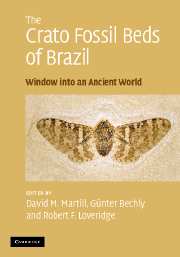Book contents
- Frontmatter
- Contents
- Contributors
- Preface
- Acknowledgements
- Part I The Crato Formation Konservat Lagerstätte
- 1 Introduction to the Crato Formation
- 2 The geology of the Crato Formation
- 3 Stratigraphy of the Crato Formation
- 4 The sedimentology and depositional environment of the Crato Formation
- 5 Commercial exploitation of the Crato Formation
- 6 Preparation techniques for Crato Formation fossils
- Part II The invertebrate fauna
- Part III The vertebrate fauna
- Part IV The flora
- Part V Miscellanea
- Appendix: species list for the Crato Formation
- Systematic index
- Plate section
- References
3 - Stratigraphy of the Crato Formation
Published online by Cambridge University Press: 22 August 2009
- Frontmatter
- Contents
- Contributors
- Preface
- Acknowledgements
- Part I The Crato Formation Konservat Lagerstätte
- 1 Introduction to the Crato Formation
- 2 The geology of the Crato Formation
- 3 Stratigraphy of the Crato Formation
- 4 The sedimentology and depositional environment of the Crato Formation
- 5 Commercial exploitation of the Crato Formation
- 6 Preparation techniques for Crato Formation fossils
- Part II The invertebrate fauna
- Part III The vertebrate fauna
- Part IV The flora
- Part V Miscellanea
- Appendix: species list for the Crato Formation
- Systematic index
- Plate section
- References
Summary
Introduction
The Crato Formation comprises a series of laminated limestones inter-bedded with sandstones, marls and clays, sandwiched between a highly variable sequence of strata in the mainly Mesozoic Araripe Basin. Its distribution has not been completely mapped as an integral stratigraphic unit, although some beds of limestone were mapped by the Projeto Santana team in the 1970s (Moraes et al., 1976). The formation has never been formally defined, although Martill and Wilby (1993) proposed a type section in the river at Cascata near Crato, but exposures of the upper part of the Crato Formation sequence are only poorly exposed here compared with elsewhere. There have been a few attempts to define the unit (e.g. Martill and Wilby, 1993; Berthou et al., 1994), but it is not always clear what authors are referring to when discussing the Crato sedimentary unit, partly due to terminology and partly due to concept. Here we consider the Crato Formation to comprise a heterolithic suite of strata lying above the Rio da Batateiras Formation of Ponte and Appi (1990) and beneath a unit of evaporites termed the Ipubi Formation by Martill and Wilby (1993) (Figure 3.1). Its base is defined as the first appearance of laminated limestones and its top by the first appearance of the evaporites of the overlying Ipubi Formation (see Figures 3.4 and 3.8, respectively, below).
- Type
- Chapter
- Information
- The Crato Fossil Beds of BrazilWindow into an Ancient World, pp. 25 - 43Publisher: Cambridge University PressPrint publication year: 2007
References
- 9
- Cited by



